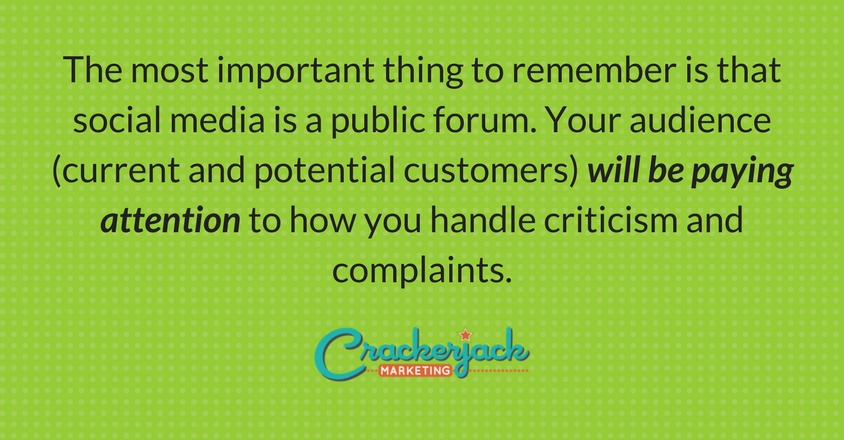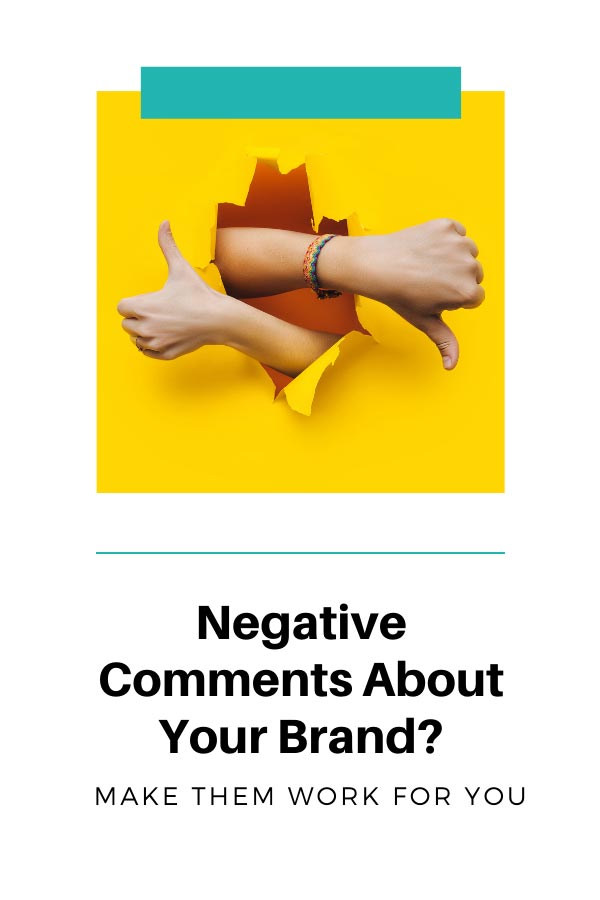Negative Comments About Your Brand? Make Them Work for You

It’s never pleasant to receive negative comments and reviews. You work hard to deliver your very best products and services, and bad feedback stings. However, every business receives negative feedback from time to time. It’s how you handle it that sets you apart and keeps your customers coming back to you despite one less-than-stellar experience. And it’s how you respond that influences new customers to give you a chance, despite any negative reviews. The most important thing to remember is that social media is a public forum. Your audience (current and potential customers) will be paying attention to how you handle criticism and complaints.

How to Handle Negative Comments About Your Brand
So how should you respond? Here’s a list of 6 best practices for dealing with negative reviews:
1. Check Your Ego at the Door
Criticism hurts no matter how tough you are or how long you’ve been in business, but suck it up, butter cup. It’s not about you, and usually, it’s not personal. The feedback you receive is all about your customer’s experience. You can’t change what’s already happened. The good news is, you can influence what happens next.
2. Respond Promptly
There’s little worse than letting negative feedback sit and fester because you don’t want to deal with it at the moment. Treat online feedback the way you would in-person complaints. If someone were to complain to a staff member onsite, how would you expect your employee to respond? Promptly, right? Respond to negative feedback you receive online with the same attention and speed you would give a customer standing right in front of you. Also, keep in mind that others will view your lack of response as an attempt to ignore the issue. If you already have an angry customer, expect the lack of response to make matters much, much worse.
3. Acknowledge the Complaint
It’s important to genuinely acknowledge the complaint. Don’t be defensive or use sarcasm. How do you want others to perceive your brand? You want to appear not only competent, but also interested in your customers. You want to demonstrate with every response that you care about customer experience. Don’t brush the problem off, make excuses, or attempt to minimize the customer’s complaint. Tell the customer you appreciate and value his feedback. Remember, it’s not necessarily what the complaint is about—it’s how you handle it that can make the biggest difference.
4. Follow Up
If the negative feedback was the result of a genuine problem with your products or services, take steps to fix the issue promptly. Then, invite your customer to try your product or service again, giving her incentive to do so. For example, you might offer a free meal or provide a discount on a future purchase.
5. Respond Publicly and Privately
In addition to responding to your customer’s comments publicly, contact him privately to address his concerns. Let him know you are genuinely sorry and want to make the issue right. Handling the issue in private demonstrates that you are truly committed to customer satisfaction and provides a personal touch customers appreciate.
6. Ask Your Customer to Remove the Negative Feedback
Once you are sure you have resolved the issues to your customer’s 100 percent satisfaction, ask her to remove the negative feedback or update it with her positive reaction to your attempts to fix the problem. Your customer may not fully understand how important positive feedback is to your business, but if asked, she may be willing to report how prompt and caring you were in resolving the issue.
Getting negative feedback isn’t the end of the world, especially if you handle it well. Use the above best practices to handle social media complaints the right way.

She’s been in social media for over 20 years, and teaches digital marketing at universities in Barcelona and Bangkok.
Follow her on LinkedIn
for expert LinkedIn and marketing advice.
STEPHANIE SCHWAB
CEO & Founder
Stephanie is the Founder and CEO of Crackerjack Marketing.
She’s been in social media for over 20 years, and teaches digital marketing at universities in Barcelona and Bangkok.
Follow her on LinkedIn
for expert LinkedIn and marketing advice.
Categories
Negative Comments About Your Brand? Make Them Work for You

It’s never pleasant to receive negative comments and reviews. You work hard to deliver your very best products and services, and bad feedback stings. However, every business receives negative feedback from time to time. It’s how you handle it that sets you apart and keeps your customers coming back to you despite one less-than-stellar experience. And it’s how you respond that influences new customers to give you a chance, despite any negative reviews. The most important thing to remember is that social media is a public forum. Your audience (current and potential customers) will be paying attention to how you handle criticism and complaints.

How to Handle Negative Comments About Your Brand
So how should you respond? Here’s a list of 6 best practices for dealing with negative reviews:
1. Check Your Ego at the Door
Criticism hurts no matter how tough you are or how long you’ve been in business, but suck it up, butter cup. It’s not about you, and usually, it’s not personal. The feedback you receive is all about your customer’s experience. You can’t change what’s already happened. The good news is, you can influence what happens next.
2. Respond Promptly
There’s little worse than letting negative feedback sit and fester because you don’t want to deal with it at the moment. Treat online feedback the way you would in-person complaints. If someone were to complain to a staff member onsite, how would you expect your employee to respond? Promptly, right? Respond to negative feedback you receive online with the same attention and speed you would give a customer standing right in front of you. Also, keep in mind that others will view your lack of response as an attempt to ignore the issue. If you already have an angry customer, expect the lack of response to make matters much, much worse.
3. Acknowledge the Complaint
It’s important to genuinely acknowledge the complaint. Don’t be defensive or use sarcasm. How do you want others to perceive your brand? You want to appear not only competent, but also interested in your customers. You want to demonstrate with every response that you care about customer experience. Don’t brush the problem off, make excuses, or attempt to minimize the customer’s complaint. Tell the customer you appreciate and value his feedback. Remember, it’s not necessarily what the complaint is about—it’s how you handle it that can make the biggest difference.
4. Follow Up
If the negative feedback was the result of a genuine problem with your products or services, take steps to fix the issue promptly. Then, invite your customer to try your product or service again, giving her incentive to do so. For example, you might offer a free meal or provide a discount on a future purchase.
5. Respond Publicly and Privately
In addition to responding to your customer’s comments publicly, contact him privately to address his concerns. Let him know you are genuinely sorry and want to make the issue right. Handling the issue in private demonstrates that you are truly committed to customer satisfaction and provides a personal touch customers appreciate.
6. Ask Your Customer to Remove the Negative Feedback
Once you are sure you have resolved the issues to your customer’s 100 percent satisfaction, ask her to remove the negative feedback or update it with her positive reaction to your attempts to fix the problem. Your customer may not fully understand how important positive feedback is to your business, but if asked, she may be willing to report how prompt and caring you were in resolving the issue.
Getting negative feedback isn’t the end of the world, especially if you handle it well. Use the above best practices to handle social media complaints the right way.

Search our Blog
Get our Free Editorial Calendar Template.
Are you stressed out by the time it takes to create great content?
In this handy Google Doc, which you can save and use on your own, you’ll get a super-simple layout to guide your content creation and management efforts.
DOWNLOAD TODAY
STEPHANIE SCHWAB
CEO & Founder
Stephanie founder and CEO of Crackerjack Marketing.
She’s been in social media for over 20 years, and teaches digital marketing at universities in Barcelona and Bangkok.
Follow her on LinkedIn
for expert LinkedIn and marketing advice.
Create your own spark
Join 5,000+ marketers who receive our B2B marketing ideas and insights each week.
Join 5,000+ marketers who receive our B2B marketing ideas and insights each week.
Who We Serve
Company
Who We Are
Our Services
Blog
Free Editorial Calendar Template
Work With Us
Resources
Chicago, Barcelona, Mumbai
1055 W. Bryn Mawr Suite F-196
Chicago, IL 60660
+1-312-429-5588
Headquarters:
© Copyright 2025 Kyle Partners, LLC, d/b/a Crackerjack Marketing. All rights reserved. | Terms of Service | Privacy Policy
